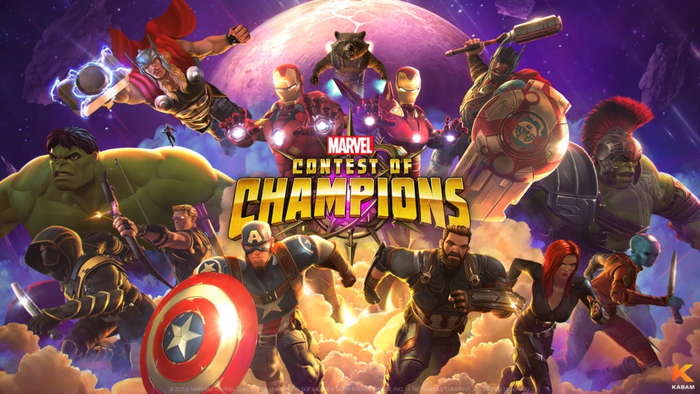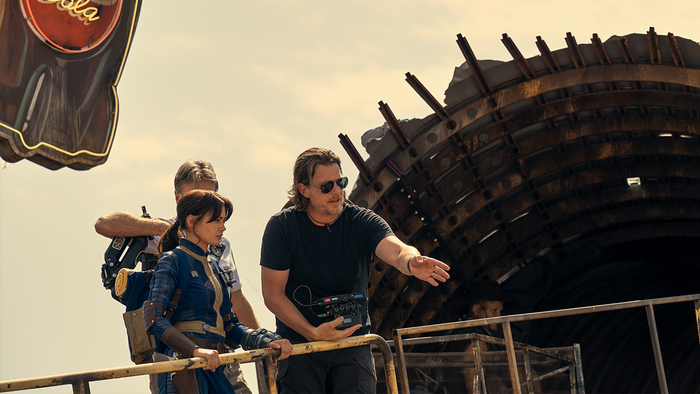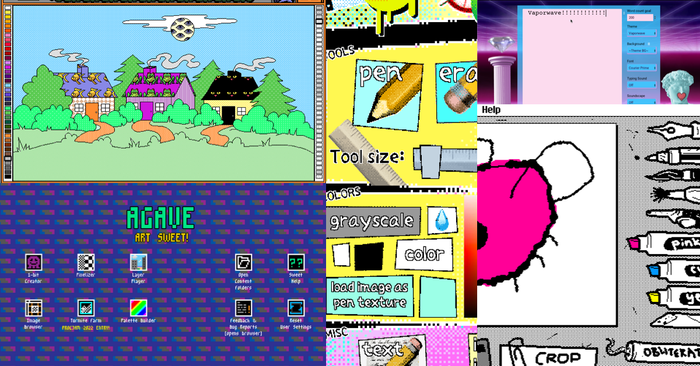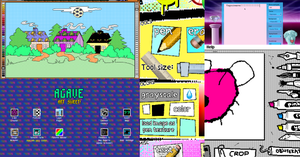
Featured Blog | This community-written post highlights the best of what the game industry has to offer. Read more like it on the Game Developer Blogs.
A deepdive into what lessons Action Games can learn from classic DOOM.

What Action Games can, imo, learn from Classic Doom
A question: how many games can you think of that were once so popular, it was installed on more computers than Microsoft Windows?
Due to its success and subsequent impact, DOOM has been analysed for nearly twenty-five years and counting. Each study aims to further unravel what made the 1993 title plus its expansion packs and sequel, tick. From its technical achievements, appreciation for speedrunning and modding to its level design – there’s plenty to cover. More than any single post can encompass.
Instead of adding to this ongoing master thesis of DOOM, I thought it would be interesting to turn it around and examine what lessons Action games (my favourite genre) can take from it, good and bad. This is going to be quite the long post, so strap in!
LEVEL DESIGN & AUTHORSHIP
DOOM’s combat is about shooting demons while moving at a lightning’s pace. The levels that house these slaughters often feature locked doors, hidden ambushes and secret chambers with extra resources, all paired with slight backtracking making them feel very open. You cannot look up or down and since it sports a considerable auto-aim, DOOM is more about positioning and speed. Each level builds on the complexity of the last, peaking with the last levels becoming a miniature maze of death to unravel.
It is those levels that are part of the first lesson imo. Originally, DOOM’s levels would be created by game-designer Tom Hall. However, programmer John Romero found them lacking for numerous reasons, one being that they didn’t play into the technology available. Unlike their previous games such as Wolfenstein 3D, DOOM would allow for different types of elevations, crooked hallways as well as being able to toy with different volumes of lighting, just to name a few.
These elements are what make DOOM’s levels stand out and even exceed many that are created today in more modern games. Episode 1, Mission 1: Hangar [E1M1], by John Romero, is the most famous example of this. Starting off in a U-shaped area with a staircase, leading to a hallway with a zigzag pattern surrounded by acid, all while being able to look outside to a seemingly unreachable place that teases you with an armour powerup.
While these elements aren’t as impressive now as they were in 1993, the mentality is, especially for Action games. With rare exceptions, most action titles offer big open spaces with the occasional hallway. Elevation is generally avoided or nothing more than a cliff to jump on. Other modern techniques that allow for newer, more interesting types of geometry or combat options – such as walking on the ceiling in Prey from 2006, flying in 2010’s DarkVoid or grappling from Sekiro – are contextualized, ignored or relegated to gimmicks, instead of being a key part of the game’s design. As technology moved forward the plethora of options that came with it seemed to have steered titles in a simpler direction.
Now one element that might have popped out is the specific mention of Romero as the designer of E1M1 while also being the programmer. Because DOOM’s levels were made with most of the assets already present, one person could make a level by himself. This allowed Romero a great deal of autonomy and, to a degree, authorship of levels. Authorship that seems to be missing in current game-design.
Now, one must mention that DOOM was made by around six people: programmers John Carmack, John Romero and Dave Taylor, artists Adrian Carmack (no relation) and Kevin Cloud and game-designer Sandy Petersen – who replaced the aforementioned Tom Hall ten weeks before the game’s release.
This is important for the following comparison. Action gaming’s more recent release was Devil May Cry V in 2019. This title has 18 game-designers, 19 environmental artists, 17 people relegated to the interface, 16 working on character art, more than 80 for animation, over 30 working on visual effects and lighting, 26 programmers and 45 just for the engine. Not to mention the staff working on audio, cinematics or any of the outsourced works like character riggers, totalling at more than 130 people working on just the product itself, nearly triple the amount that worked on the first Devil May Cry from 2001. And that’s not to mention management, marketing and other departments that are involved.
Why is this? Though an overly simplified statement, making games in the current day and age takes much more manpower than before if you want to keep up visually. This is thanks to the jump to 3D requiring more complex rigging, motion capture, higher frame rates and resolutions and more complicated coding and engines to accompany them. All of this demands stronger hardware, with the end result being more error-sensitive and less flexible. Sprite based King of Fighters XIII’s team needed nearly 16 months to make a single character for example, juggling multiple at a time with long hours to see the game launch on time. Expectations of what a full price game is supposed to look like have gone up, as evident by the fan backlash of a title like Mass Effect: Andromeda.
This drive to keep up with the ever-shifting visual benchmark could be a cause to authorship taking a backseat. While the sector has its names, like Kojima, Jaffe and Ancel, these are more directors that guide the vision of the product, not people that handcraft a whole set of levels themselves.
In the documentary for Ninja Gaiden II, director Itagaki was seen testing most encounters in Ninja Gaiden II personally. While admirable, any changes wouldn’t then be made by a single individual; instead one cog would force another in motion, and another, and another.
If, during the final ten weeks of development on Devil May Cry V, director Itsuno had wanted one entire mission to be redone, it would’ve been a monumental undertaking. Conversely, despite being hired ten weeks before the game’s launch, Sandy Petersen was able to make 19 of DOOM’s 27 levels, though 8 were based on early sketches by Tom Hall.
At the same time they were also given a distinct feeling, like Petersen’s love for ambushes and themes. Themes that served as a red line throughout, such as a level based solely around exploding barrels [DOOM II: Map23: Barrels o’ Fun]. A different example is Romero’s emphasis on contrast i.e. light and dark and compact versus open. All these thematic levels flow into each other and have players revisit older areas to build a map in their head.
Today there are, simply put, too many moving parts for a game’s design process to be as flexible as DOOM**’s was in 1993.**
As such, it should be no surprise that most of the levels in modern Action games consist of open spaces or simple shapes when looked at from above. Their simplicity is hidden behind good art-design, stronger visuals and filled with story moments or interesting encounters. Which as a result have the games rely more on their immediate gameplay than the levels they take place in.
An example of their comparison: https://i2.wp.com/stinger-magazine.com/wp-content/uploads/2019/11/[email protected]
I placed the map for E1M7 from DOOM next to that of one I made based off of Devil May Cry V's mission 11 map - one of the more complexer ones. While I had to base it off of video footage, and thus is a tad more simplistic, it does paint a pretty telling picture.
DOOM’s method of level-design comes with a downside though, namely the inconsistent quality. While the levels in DOOM’s first episode, Knee Deep in the Dead, were nearly wholly designed by Romero, later expansions and games would feature more of a mishmash of designers. Sometimes you’d play maps from 4 different designers in a row each of varying quality and with different design philosophies and logic, leading to an inconsistent title.
All in all though, the First Lesson that Action games could learn from DOOM is this:
Action games currently focus on the immediate gameplay, and not a lot on where said gameplay takes place. Level design should embrace current technological development more to offer new types of levels, interesting method of traversal, gameplay or combat scenarios. All while avoiding gimmicks and staying true to their current vision. The open arena is great, but use it more sparingly.
Aside from that, technologies have become too vast, too complex and too focused on high detail to let a single person make a level. Instead it falls back on the combat and art direction to do the work for them. It would be interesting to see a title in the genre focus less on the resolution of the texture or the quality of the cloth physics and instead allow for more flexibility in the game’s design process. In an effort to keep the design consistent, unlike DOOM*, there’d have to be a leading designer that monitors the level’s cohesion with each other.*
ENEMIES, WEAPONS & HOW IT ALL COMES TOGETHER
How exactly those levels play out though is determined by the enemies and the weapons that kill them. Foes in DOOM run at you and shoot at you in various ways and some might even be used to kill each other. But that is not what makes DOOM’s combat tick. A Pinkie is a near brain dead foe whose only purpose in life is to rush at you for a bite. An Imp will at random occasions fire orbs at you. It seems very basic.
When that single Pinkie is supported by an Imp however, the battle changes. What was once just a simple matter of keeping distance now also involves dodging a projectile. Add a pool of lava around the arena and it changes even more. Twelve steps further and we’ve laid down the foundation for an arena with multiple levels of elevation, different enemy types working together to put the player in unique situations, while the environmental hazards keep him in check.
Each demon in DOOM has a distinct theme making for interesting engagements not when alone, but when they are combined. An element taken even further when taking into account which weapons the player will have.
The first mission of each episode resets your loadout. Designing which weapon can be picked up in certain missions also influences the combat further; a battle against three Barons of Hell can be very different not only depending on the room you’re in, but also whether you have a Plasma Gun to rely on or just a regular shotgun.
Later encounters in the game tend to devolve into large fights however. A once nuanced encounter devolves into waves of enemies huddled together, especially in DOOM’s third episode and the latter half of DOOM II. This can be attributed to the designers having to compensate the player’s rising skill level and improved load-out plus the fact that DOOM tends to show its cards quite early. Most enemies will have been encountered as early as halfway through the game with the remaining levels being more about experimentation with DOOM’s offerings. Eventually each possible combination has been made and levels will start to either mirror their design or rely on gimmicks, like hordes of enemies. While sometimes this works to entertain, other times it will just annoy and pad out the game.
Encounters also change depending on the difficulty-mode. Ultra Violence might add a Cacodemon in that one key area, whose projectiles change the dynamic completely. Meanwhile Nightmare difficulty speeds up enemies and projectiles while also respawning killed foes after a set time. All difficulties also change item locations and offer unique weapon pickups. A good example is Episode 4, Mission 1: Hell Beneath [E4M1], by American McGee, which famously removed all medkits on Ultra Violence and Nightmare, turning an already hard level into arguable the series’ hardest. Or how Episode 1, Mission 3: Toxic Refinery [E1M3], by John Romero, removes certain lights making it harder to see in some encounters.
This methodology also gives level designers the freedom to construct numerous versions of each level with unique enemy encounters with specific skill levels in mind.
For example the expansion pack The Plutonia Experiment by the brothers Dario and Milo Casali. One mission in this expansion features nine Arch-viles, one of the game’s most dangerous foes. By comparison, DOOM II only features one fight with two Arch-viles near the end. Same goes for the Cyberdemon, the boss of DOOM’s second episode. He tends to be used as a chokepoint offering a tight encounter. Plutonia throws four at once at you.
Dario has gone on record saying that the expansion was made for people who had finished DOOM II on Hard and were looking for a challenge using all the elements from the game and putting them to their most extreme use. He noted that he’d always played through the level he’d made on Hard, and if it was beaten too easily, it would be made harder. Dario went on to state that he didn’t have a lot of sympathy for players who played Plutonia on Hard and complain it’s ‘too hard’.
Images cannot do The Plutonia Experiment justice. So please enjoy this video showing its insanity, courtesy of the fantastic Civvie11: https://www.youtube.com/watch?v=cVyMsAja5z8
Aside from catering to the hardcore, DOOM also uses its difficulty modes for newer players to be eased into the game on lower settings. It would offer smaller encounters with less dangerous foes and more health-pickups or give certain powerful weapons earlier. It doesn’t coddle new players with gameplay changes like auto-aim (Vanquish), regenerating health (Resident Evil 2 Remake), letting the game do the fighting for you (Bayonetta 2) or having you dodge automatically (Ninja Gaiden 3). These are changes that never teach you how to play the game, but play it for you.
It is clear that DOOM strives to make the best of what little elements it has to offer. And that is exactly Action gaming’s Second Lesson that it can learn from it:
The foundation of a great Action game is generally present in current day titles, with a fantastic cast of enemies, moves that are available to the player and how they interact. Instead of taking this for granted, modern titles could benefit from further experimenting on how all those foes and abilities come together. Introducing a foe shouldn’t be the end of it, it should be the beginning of trying engagement setups and unique level-designs built to give the foe a new twist each and every time, making it feel fresh. Combine foes that would have no reason to team up, and if immersion is risked to be broken, relegate these unique encounters to higher difficulty settings only. If your game is too challenging, offer unique lower settings to ease newcomers in.
Play with enemy combinations and weapon setups and don’t be afraid to use multiple difficulty levels to try out newer and more dangerous encounters or gimp the player with different item locations. As a bonus, allow players to make their own maps down the line. Dante’s Inferno’s Trials of Lucia had the right idea, but was badly executed. Who knows what fantastic fights await if players could design their own? One need but look to Super Mario Maker for the endless creativity.
MOVEMENT IN ACTION
If there’s one key element in all of the aforementioned fights in DOOM, it is movement. Where you are, where you enemy is and how you can you bridge the gap. Regular movement aside, Action games offer a plethora of other options in this regard. From Ninja Gaiden’s wallrunning, Shinobi’s dash to Devil May Cry 3’s teleport. One thing that’s consistent with these types of movement though is that they are static and when the character starts to attack, that move is static as well.
When Dante attacks, he cannot move, similarly to how Ryu stops being agile the second he readies his blade. While there are some attacks that have movement tied into them, like Ninja Gaiden’s Windmill Slash or Devil May Cry’s Stinger, these tend to be pre-defined. And when movement does take place, it is mostly used for a quick dodge or reposition with a specific set distance and angle, only for the offensive to start once again, with halted movement.
As a result, plenty of the tricks in these games are about staying on the offensive through canceling animations or keeping a foe pressured so you can stay right in his face. This is sharp contrast to DOOM where movement and positioning combined with attacking is key, understandable considering its genre. This is highlighted further with most of its hidden mechanics contributing to movement speed and mobility, like SR50, Strafe Running, Gliding and Wall Running.
That’s not to say some Action games haven’t already done this. Players can move while attacking in The Wonderful 101 and then there’s Raiden’s Ninja Run in Metal Gear Rising: Revengeance. Some games also put movement as a weapon ability like Nioh’s Tonfa, which can be canceled with a press of a button. Generally speaking though, unlike their 2d brethren like Ninja Gaiden III: The Ancient Ship of Doom or Muramasa: The Demon Blade, movement in combat seems to be heavily stilted in modern Action games.
In Devil May Cry 4 players would use the momentum of previously canceled attacks to generature movement for subsequent moves, allowing players to move while attacking to an extent, often dubbed as Inertia. An example of this would be Guard Flying. When removed from Devil May Cry 5, this was justifiably met with controversy and discussion, since this meant a sizable portion of the game’s offensive mechanics was removed. This highlights a great desire for such movement in combat.
So why is this element mostly exclusive to games like DOOM 2016, Vanquish, Max Payne 3 and the upcoming Nelo, and not present in games that actively promote mobility like Shinobi or even Assassin’s Creed?
One argument as to why can be made that giving players such mobility could result in too easy a game. Metal Gear Rising had to force enemies to automatically counter attacks after blocking a certain amount of hits to prevent Ninja Running from locking enemies down completely.
Another argument can be that it can make attacks feel less powerful. While not important mechanically, a lot of the visual appeal from an attack comes from elements like anticipation in animation, timing, body movement and the enemy’s reaction. Attacking while on the move can see animations lack build-up and have them be less grounded, making the resulting move feel floaty.
For it to truly work though, enemies have to play into it, which is currently not the case. Foes are made to be fought head on with only rare exceptions. Looking to DOOM II, Arch-viles are completely built around line of sight, shotgunners need to be avoided using terrain and Pinkies are a huge danger in enclosed areas. Such a change in enemy design could open action gaming to foes that dodge around much more often or use line of sight moves more akin to the medusa-like Nure-Onna’s gaze in Nioh 2.
It’s an interesting proposition; an action game where the act of doing the attack is but one part of the whole while the constant movement, control and positioning of the character during such an attack is just as important.
As such, the third, and last, lesson that action games can learn from DOOM isn’t just as much a lesson, but also a spark for inspiration:
Too many action games focus on movement being stilted while being on the offensive. While originally 2d Action games were all about movement in combat, combat is now about moving until you’re engaged in a fight, at which point your position is frozen until defensive actions need to be taken again.
Action games could benefit from experimenting with movement inside the combat area and how this plays into the different types of foes. Movement should become more of a mechanic in Action games outside of avoiding attacks, it should play more into the combat as well. Be it through a unique weapon or a game built around it.
CONCLUSION
There are of course other little lessons to be gained from classic DOOM. How the levels are filled with well hidden secrets that reward exploration, how little pickups for armour always made said exploration worthwhile, its open ranking screen that promoted all types of challenge runs and the detailed way of how the Big Fucking Gun’s hidden tracer-mechanic allowed for more expert play. Mistakes can also be lessons, like the overlap of certain weapons, lackluster boss fights or dull variation in level-aesthetics in DOOM II. One could even look to DOOM 2016 for inspiration, such as its showcase in how weapon upgrades could be handled properly.
It is important to note that all these lessons, big and small, are generalized and can never fit every game or style. The older Resident Evil games should not have higher movement in combat for instance, nor do any of these lessons guarantee more sales. Instead, the general notion I feel is this: Action games have been around for a long, long time, but since the release of the Playstation 2 they have slowly started to settle into the mold laid down by Rising Zan that was further cemented by Devil May Cry. If anything, let this post serve as an inspiration that there can be more elements to look at and new avenues to explore into how combat is constructed and made interesting. I hope that future installments of my beloved genre seek to inspire once again!
SOME FUN NOTES I FOUND WHILE RESEARCHING THIS POST
Apparently the lead environmental artist for Devil May Cry V is named Shinji Mikami. Not to be confused with the Shinji Mikami;
Originally I wanted Armour Pickups were going to be a lesson of their own, but I decided against it as it wasn’t major enough. The general idea is that the way armour works in DOOM is that regular armours only bring you to 100 armour, no more. But little armour chunks can get you above 100 to a maximum of 200. There are a lot of secrets in DOOM that as a basic reward have little chunks of armour. It is a simple method of rewarding players with something useful that can always stack and tends to expire. You can sort of see this in Viewtiful Joe, where each chapter requires you to collect film canisters to upgrade your VFX-meter;
A lot of the names used throughout the post for DOOM’s weapons and enemies are a mixture of those present in the official manual and their more popularized terms in the community. For example, while the manual calls it the Plasma Rifle, most players call it the Plasma Gun. Similarly no-one writes the shotgun with a capital ‘s’, so I avoided that. Other foes like shotgunners and Pinkies are more common terms, while their official names, Former Human Sergeant and Demon, are rarely used. I also decided to just write out Big Fucking Gun instead of BFG, as I felt more people would understand what I was talking about if I did so. That and I just wanted to write the word “fucking”;
Infighting between enemies in DOOM isn’t really mentioned. The reason is mostly that the post was getting long enough. There have been Action games that toyed with this, such as Asura’s Wrath where enemies could damage each other;
Summoning characters like Sieg from Chaos Legion, Akira from Astral Chain and V from Devil May Cry V were considered to be mentioned in the lesson about movement. I’ve always felt it interesting that you could order monsters to attack while you move, but generally these player characters did suffer from the same limitation in the end as well once they attacked themselves, so I left them out to avoid confusion. That, and that part of the article had enough references as it is;
Nightmare was a difficulty mode in DOOM that was aparrently originally put in to quell possible complaints that Ultra Violence difficulty was too easy. As a result most players considered it a joke difficulty, but it still has its adamant fans;
The methodology of enemies and item locations changing on higher difficulties is only fully revisited on DOOM’s scale in Ninja Gaiden Black (at least to my knowledge), where each difficulty changes enemies, item locations, scarab rewards and even introduced new bosses. This saw each difficulty mode play like its own unique game. Some modes at times even contained harder enemy encounters than in harder modes, which had to compensate for their higher damage output. The same goes with how Ninja Dog’s difficulty urged players to become better, instead of coddling them too much. This article by Shane Eric Dent is a great read on the matter;
After much looking around, generally speaking the game itself is stylized as DOOM, while the builder is stylized as Doom. This inconsistency hurts my eyes, but it is the way it is;
And yes, American McGee is his real name. The story behind it is, as he puts it: “Yes, my mother named me that. She claims a woman she knew in college, who named her daughter ‘America’, inspired the name. She also tells me that she was thinking of naming me ‘Obnard’. She was and always has been a very eccentric and creative person”;
For this post I decided to try my hands at Doom Builder myself. While not finished, it is interesting to witness just what a difference a single Lost Soul can make to your combat encounter. Especially how the game’s infighting can make each fight feel different. You can download the levels here, but be warned…they aren’t very good!
Originally posted on: https://stinger-magazine.com/article/classic-doom/
Read more about:
Featured BlogsAbout the Author(s)
You May Also Like








